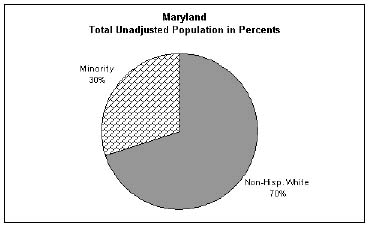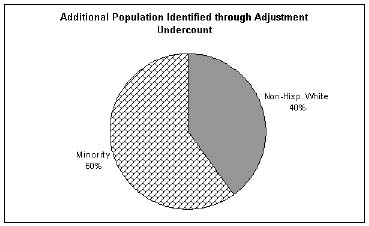State-by-State Analysis: Maryland
The
1990 undercount and its demographic composition
As
indicated in Table 1, the percentage undercount of 2.1 percent in Maryland
was higher than the national average of 1.6 percent and resulted in a net
numerical undercount of 100,984 persons, ninth highest in the nation. For
non-Hispanic whites, Table 1 indicates, the undercount percentage was 1.2
percent, as compared to 4.2 percent for members of minority groups. As indicated
in Table 2 and the summary Chart below, these differentials between whites
and minorities resulted in an undercounted population with a much greater
minority group percentage than the state's total population. Minorities
comprised 30 percent of the state's uncorrected population, compared to
60 percent of the state's undercounted population. In numerical terms, the
undercount consisted of 40,183 non-Hispanic whites and 60,801 members of
minority groups. In Maryland, minority group members are primarily non-Hispanic
blacks. According to corrected data, 81 percent of minority group members
in Maryland are non-Hispanic blacks, 9 percent are Hispanics, and 10 percent
are members of other minority groups.


Implications
of 1990 Census adjustment for minority voter opportunities
The use of
corrected data in Maryland for the post-1990 redistricting would have had
the potential to enhance minority voter opportunities in the plans drawn
for the State Senate and State House. In the Maryland State Senate, the
use of corrected data would have created an opportunity to draw an additional
majority-minority district. State Senate District 20, located in Montgomery
County in the post-1990 plan, includes a minority population of 48.2 percent.
However, application of the corrected data for 1990 demonstrates that the
population of this District is more accurately measured at 49.4 percent,
close to the 50 percent mark. Moreover, the use of corrected data uncovers
sufficient additional minority population in Montgomery County to have created
the opportunity to draw District 20 with a majority-minority population.
The use of corrected data in Montgomery County discloses an additional 14,147
persons, including 8,508 members of minority groups (60 percent). Given
that Senate Districts in Montgomery County were all larger than the ideal
district in the post-1990 redistricting, this increased population would
have been sufficient to account for the increased population of an ideal
Senate district resulting from the use of corrected rather than uncorrected
Census data. The size of an ideal Senate District would increase from 101,733
to 103,882, for a net increase of 2,149 persons.
In addition,
State Senate District 21, in Prince George's County in the post-1990 plan,
has a minority population of 44.2 percent. The use of corrected data uncovers
sufficient additional minority population in Prince George's County to have
created the opportunity to draw District 21 with an enhanced majority-minority
population. The use of corrected data in Prince George's County discloses
an additional 22,327 persons, including 18,519 members of minority groups
(83 percent). This increased population would have been more than sufficient
to account for the increased population of an ideal Senate district resulting
from the use of corrected rather than uncorrected Census data.
The use of
corrected rather than uncorrected census data in Maryland would have had
an even more substantial impact on State House districts. In the Maryland
State House, District 22A in Prince Georges County (which elects two members
of the State House) in the post-1990 redistricting plan has a minority population
of 49.1 percent. However, application of the corrected data for 1990 demonstrates
that the population of this District is more accurately measured at 50.2
percent. District 20, analyzed above, is not only a State Senate district,
but also a three-member State House district as well. Likewise Senate District
21, also analyzed above, is a three-member State House district as well.
Enhanced minority populations in these two districts would have affected
both State Senate and State House elections in Maryland.





